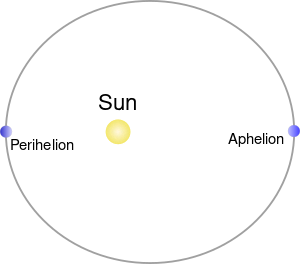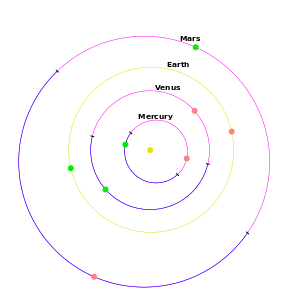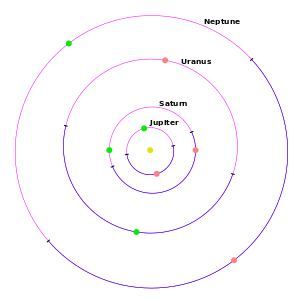قبا
القبا Apsis، في الميكانيكا السماوية، هي كلّ نقطة على مسار مركزيّ يكون بعدها عن مركز القوّة أكبر أو أصغر ما يمكن. بين يوهانس كيبلر أن مدارات الكواكب تكون في شكل قطع ناقص حيث تحتل الشمس (مركز القوة) إحدى بؤرتي القطع الناقص . ينتج عن ذلك أن الكوكب في مداره يكون أحيانا قريبا من الشمس (وتزداد سرعته خلال تلك الفترة ) وأحيانا أخرى يكون فيها بعيدا عن الشمس بعد نصف دورة (بالتالي تنخفض سرعته خلال تلك الفترة) . هذان الموضعان على مدار كوكب أو أي جرم سماوي يسميان أوج عندما يكون الكوكب بعيدا عن مركز القوة ، و حضيض عندما يكون الكوكب قريبا من مركز القوة . وينطبق ذلك أيضا على أي قمر صناعي يدور حول الأرض ، أحيانا يكون قريبا منها (في الحضيض)، وأحيانا يكون بعيدا عنها (في الأوج) ،إلا إذا كان مداره دائري تماما.
الصيغة الرياضية

العلاقة بين الاختلاف المركزي ومسافتي القبا : الأوج و الحضيض هي:
حيث:
- Apoapsis distance أوج (فلك)
- Periapsis distance حضيض (فلك)
- الاختلاف المركزي Exzentrizity
المصطلح
| الجرم | Closest approach | Farthest approach |
|---|---|---|
| عام | Periapsis/Pericenter | Apoapsis/Apocenter |
| مجرة | Perigalacticon[1] | Apogalacticon |
| نجم | Periastron | Apastron |
| ثقب أسود | Perimelasma/Peribothra/Perinigricon | Apomelasma/Apobothra/Aponigricon |
| الشمس | Perihelion | Aphelion |
| عطارد | Perihermion | Aphermion |
| الزهرة | Pericytherion/Pericytherean/Perikrition | Apocytherion/Apocytherean/Apokrition |
| الأرض | Perigee | Apogee |
| القمر | Periselene/Pericynthion/Perilune | Aposelene/Apocynthion/Apolune |
| المريخ | Periareion | Apoareion |
| المشترى | Perizene/Perijove | Apozene/Apojove |
| زحل | Perikrone/Perisaturnium | Apokrone/Aposaturnium |
| أورانوس | Periuranion | Apouranion |
| نپتون | Periposeidion | Apoposeidion |
المحاور المرجعية لمدار الأرض
يسمى الخط الذي يربط بين نقطتي الأوج والحضيض "بالمحور الرئيسي"، وهو أكبر محور في قطع ناقص. وبسبب جاذبية الكواكب الأخرى فلا يبقى المحور الأساسي ثابتا وإنما يدور بطيئا في اتجاه الجرم الأم (الشمس). ويسمى ذلك دوران الأوج (أو دوران الحضيض).
- أوج الأرض apoapsis حول الشمس : مسافة 152 مليون كيلومتر
- حضيض الأرض periapsis حول الشمس: مسافة 147 مليون كيلومتر.
الأوج والحضيض
The perihelion (q) and aphelion (Q) are the nearest and farthest points respectively of a body's direct orbit around the Sun.
Comparing osculating elements at a specific epoch to effectively those at a different epoch will generate differences. The time-of-perihelion-passage as one of six osculating elements is not an exact prediction (other than for a generic two-body model) of the actual minimum distance to the Sun using the full dynamical model. Precise predictions of perihelion passage require numerical integration.
Inner planets and outer planets
The two images below show the orbits, orbital nodes, and positions of perihelion (q) and aphelion (Q) for the planets of the Solar System[2] as seen from above the northern pole of Earth's ecliptic plane, which is coplanar with Earth's orbital plane. The planets travel counterclockwise around the Sun and for each planet, the blue part of their orbit travels north of the ecliptic plane, the pink part travels south, and dots mark perihelion (green) and aphelion (orange).
The first image (below-left) features the inner planets, situated outward from the Sun as Mercury, Venus, Earth, and Mars. The reference Earth-orbit is colored yellow and represents the orbital plane of reference. At the time of vernal equinox, the Earth is at the bottom of the figure. The second image (below-right) shows the outer planets, being Jupiter, Saturn, Uranus, and Neptune.
The orbital nodes are the two end points of the "line of nodes" where a planet's tilted orbit intersects the plane of reference;[3] here they may be 'seen' as the points where the blue section of an orbit meets the pink.
The perihelion (green) and aphelion (orange) points of the inner planets of the Solar System
The perihelion (green) and aphelion (orange) points of the outer planets of the Solar System
Lines of apsides
The chart shows the extreme range—from the closest approach (perihelion) to farthest point (aphelion)—of several orbiting celestial bodies of the Solar System: the planets, the known dwarf planets, including Ceres, and Halley's Comet. The length of the horizontal bars correspond to the extreme range of the orbit of the indicated body around the Sun. These extreme distances (between perihelion and aphelion) are the lines of apsides of the orbits of various objects around a host body.
حضيض وأوج الأرض
| سنة | الحضيض | الأوج | ||
|---|---|---|---|---|
| تاريخ | ساعة | تاريخ | ساعة | |
| 2010 | January 3 | 00:09 | July 6 | 11:30 |
| 2011 | January 3 | 18:32 | July 4 | 14:54 |
| 2012 | January 5 | 00:32 | July 5 | 03:32 |
| 2013 | January 2 | 04:38 | July 5 | 14:44 |
| 2014 | January 4 | 11:59 | July 4 | 00:13 |
| 2015 | January 4 | 06:36 | July 6 | 19:40 |
| 2016 | January 2 | 22:49 | July 4 | 16:24 |
| 2017 | January 4 | 14:18 | July 3 | 20:11 |
| 2018 | January 3 | 05:35 | July 6 | 16:47 |
| 2019 | January 3 | 05:20 | July 4 | 22:11 |
| 2020 | January 5 | 07:48 | July 4 | 11:35 |
| 2021 | January 2 | 13:51 | July 5 | 22:27 |
| 2022 | January 4 | 06:55 | July 4 | 07:11 |
| 2023 | January 4 | 16:17 | July 6 | 20:07 |
| 2024 | January 3 | 00:39 | July 5 | 05:06 |
| 2025 | January 4 | 13:28 | July 3 | 19:55 |
| 2026 | January 3 | 17:16 | July 6 | 17:31 |
| 2027 | January 3 | 02:33 | July 5 | 05:06 |
| 2028 | January 5 | 12:28 | July 3 | 22:18 |
| 2029 | January 2 | 18:13 | July 6 | 05:12 |
الكواكب الأخرى
The following table shows the distances of the planets and dwarf planets from the Sun at their perihelion and aphelion.[4]
| Type of body | Body | Distance from Sun at perihelion | Distance from Sun at aphelion | difference (%) | insolation difference (%) |
|---|---|---|---|---|---|
| الكوكب | Mercury | 46,001,009 km (28,583,702 mi) | 69,817,445 km (43,382,549 mi) | 34% | 57% |
| Venus | 107,476,170 km (66,782,600 mi) | 108,942,780 km (67,693,910 mi) | 1.3% | 2.8% | |
| Earth | 147,098,291 km (91,402,640 mi) | 152,098,233 km (94,509,460 mi) | 3.3% | 6.5% | |
| Mars | 206,655,215 km (128,409,597 mi) | 249,232,432 km (154,865,853 mi) | 17% | 31% | |
| Jupiter | 740,679,835 km (460,237,112 mi) | 816,001,807 km (507,040,016 mi) | 9.2% | 18% | |
| Saturn | 1,349,823,615 km (838,741,509 mi) | 1,503,509,229 km (934,237,322 mi) | 10% | 19% | |
| Uranus | 2,734,998,229 km (1.699449110×109 mi) | 3,006,318,143 km (1.868039489×109 mi) | 9.0% | 17% | |
| Neptune | 4,459,753,056 km (2.771162073×109 mi) | 4,537,039,826 km (2.819185846×109 mi) | 1.7% | 3.4% | |
| Dwarf planet | Ceres | 380,951,528 km (236,712,305 mi) | 446,428,973 km (277,398,103 mi) | 15% | 27% |
| Pluto | 4,436,756,954 km (2.756872958×109 mi) | 7,376,124,302 km (4.583311152×109 mi) | 40% | 64% | |
| Haumea | 5,157,623,774 km (3.204798834×109 mi) | 7,706,399,149 km (4.788534427×109 mi) | 33% | 55% | |
| Makemake | 5,671,928,586 km (3.524373028×109 mi) | 7,894,762,625 km (4.905578065×109 mi) | 28% | 48% | |
| Eris | 5,765,732,799 km (3.582660263×109 mi) | 14,594,512,904 km (9.068609883×109 mi) | 60% | 84% |
الصيغ الرياضية
These formulae characterize the pericenter and apocenter of an orbit:
- Pericenter
- Maximum speed, , at minimum (pericenter) distance, .
- Apocenter
- Minimum speed, , at maximum (apocenter) distance, .
While, in accordance with Kepler's laws of planetary motion (based on the conservation of angular momentum) and the conservation of energy, these two quantities are constant for a given orbit:
where:
- is the distance from the apocenter to the primary focus
- is the distance from the pericenter to the primary focus
- a is the semi-major axis:
- μ is the standard gravitational parameter
- e is the eccentricity, defined as
Note that for conversion from heights above the surface to distances between an orbit and its primary, the radius of the central body has to be added, and conversely.
The arithmetic mean of the two limiting distances is the length of the semi-major axis a. The geometric mean of the two distances is the length of the semi-minor axis b.
The geometric mean of the two limiting speeds is
which is the speed of a body in a circular orbit whose radius is .
Time of perihelion
Orbital elements such as the time of perihelion passage are defined at the epoch chosen using an unperturbed two-body solution that does not account for the n-body problem. To get an accurate time of perihelion passage you need to use an epoch close to the perihelion passage. For example, using an epoch of 1996, Comet Hale–Bopp shows perihelion on 1 April 1997.[5] Using an epoch of 2008 shows a less accurate perihelion date of 30 March 1997.[6] Short-period comets can be even more sensitive to the epoch selected. Using an epoch of 2005 shows 101P/Chernykh coming to perihelion on 25 December 2005,[7] but using an epoch of 2012 produces a less accurate unperturbed perihelion date of 20 January 2006.[8]
| Epoch | Date of perihelion (tp) |
|---|---|
| 2010 | 2024-Apr-19.892 |
| n-body[9] | 2024-Apr-21.139 |
| 2018 | 2024-Apr-23.069 |
Numerical integration shows dwarf planet Eris will come to perihelion around December 2257.[10] Using an epoch of 2021, which is 236 years early, less accurately shows Eris coming to perihelion in 2260.[11]
4 Vesta came to perihelion on 26 December 2021,[12] but using a two-body solution at an epoch of July 2021 less accurately shows Vesta came to perihelion on 25 December 2021.[13]
الأقواس القصيرة
Trans-Neptunian objects discovered when 80+ AU from the Sun need dozens of observations over multiple years to well constrain their orbits because they move very slowly against the background stars. Due to statistics of small numbers, trans-Neptunian objects such as 2015 TH367 when it had only 8 observations over an observation arc of 1 year that have not or will not come to perihelion for roughly 100 years can have a 1-sigma uncertainty of 77.3 years (28,220 days) in the perihelion date.[14]
انظر أيضاً
- Distance of closest approach
- Eccentric anomaly
- Flyby (spaceflight)
- Hyperbolic trajectory#Closest approach § Notes
- Mean anomaly
- Perifocal coordinate system
- True anomaly
- الأوج
- الحضيض
- قطع ناقص
- قوانين كبلر
- حقبة (فلك)
المصادر
- ^ Croswell, Ken (1995). The Alchemy of the Heavens. Anchor Books. ISBN 0-385-47214-5.
- ^ "the definition of apsis". Dictionary.com. Archived from the original on December 8, 2015. Retrieved November 28, 2015.
- ^ Darling, David. "line of nodes". The Encyclopedia of Astrobiology, Astronomy, and Spaceflight. Archived from the original on August 23, 2019. Retrieved May 17, 2007.
- ^ "NASA planetary comparison chart". Archived from the original on August 4, 2016. Retrieved August 4, 2016.
- ^ "JPL SBDB: Hale-Bopp (Epoch 1996)". Archived from the original on July 16, 2020. Retrieved July 16, 2020.
- ^ "JPL SBDB: Hale-Bopp". Archived from the original on July 17, 2020. Retrieved July 16, 2020.
- ^ "101P/Chernykh – A (NK 1293) by Syuichi Nakano". Archived from the original on October 3, 2020. Retrieved July 17, 2020.
- ^ JPL SBDB: 101P/Chernykh (Epoch 2012)
- ^ "Horizons Batch for 12P/Pons-Brooks (90000223) at 2024-Apr-21 03:20" (Perihelion occurs when rdot flips from negative to positive). JPL Horizons. Archived from the original on 2023-02-12. Retrieved 2023-02-11. (JPL#K242/3 Soln.date: 2022-Oct-24)
- ^ "Horizons Batch for Eris at perihelion around 7 December 2257 ±2 weeks". JPL Horizons (Perihelion occurs when rdot flips from negative to positive. The JPL SBDB generically (incorrectly) lists an unperturbed two-body perihelion date in 2260). Jet Propulsion Laboratory. Archived from the original on September 13, 2021. Retrieved 13 September 2021.
- ^ "JPL SBDB: Eris (Epoch 2021)". Archived from the original on January 31, 2018. Retrieved January 5, 2021.
- ^ "Horizons Batch for 4 Vesta on 2021-Dec-26" (Perihelion occurs when rdot flips from negative to positive). JPL Horizons. Archived from the original on September 26, 2021. Retrieved 2021-09-26. (Epoch 2021-Jul-01/Soln.date: 2021-Apr-13)
- ^ JPL SBDB: 4 Vesta (Epoch 2021)
- ^ "JPL SBDB: 2015 TH367". Archived from the original on March 14, 2018. Retrieved September 23, 2021.
{{cite web}}: CS1 maint: bot: original URL status unknown (link)
وصلات خارجية
- Apogee - Perigee Photographic Size Comparison, perseus.gr
- Aphelion - Perihelion Photographic Size Comparison, perseus.gr
- Earth's Seasons: Equinoxes, Solstices, Perihelion, and Aphelion, 2000-2020, usno.navy.mil





